CANADA HOUSING MARKET: NO NEW YEAR RESOLUTIONS
SUMMARY
Canadian home sales fell 3% (sa m/m) in January, while listings moved in the opposite direction, rising by 3.3%, recovering only half of last month’s decline. This pullback in sales combined with the increase in listings eased the sales-to-new listings ratio, an indicator of how tight the market is, to 50.7%, pushing the national housing market further into balanced territory. Months of inventory continued to climb up from record lows, reaching 4.3 months—a significant improvement from its all-time low of 1.7 months in early 2022, but still a full month below its long-term average.
Of the 31 local markets we track, 19 started the year in balanced territory compared to 24 at the end of 2022. Three markets, Vancouver, Victoria, and Okanagan-Mainline, joined Toronto, Barrie, and Windsor, in buyers’ territory, while Lethbridge and Quebec City joined the sellers’ market ranks.
Prices declined again in January in line with a more balanced market. The composite MLS Home Price Index (HPI) edged down 1.9% (sa m/m) in January, starting the year 15% below its February 2022 peak, and 30% above pre-pandemic levels. Single-family homes continued to lead monthly price declines, falling by 2.3%, with the larger two-storeys segment declining by 2.5%, compared to only 1.5% and 1.1% declines for townhomes and apartments respectively. Relative to January 2022 the composite MLS HPI (nsa) was 12.8% lower, with single-family homes 14.8% lower and apartments 3.8% lower, the first time this segment records an annual decline since September 2019.
IMPLICATIONS
Finally, Canada’s housing market and several people have something in common, no big new year resolutions for 2023. (Please refer to last month’s report for a comprehensive summary of the 2022 housing market.)
Canada’s housing market started the year continuing much of the trend of the past few months. Sales eased, while listings remained in short supply despite January’s increase, with many sellers remaining on the sidelines due to price and general economic environment uncertainty. Historically low listings are likely subduing both sales activity and also the impact of demand softness on prices.
We continue to see more room for prices to decline in some markets. The expected eventual uptick in demand driven by population growth, resilient labour markets, and the expected stabilization in the Bank of Canada’s policy rate with the predicted decline in inflation, coupled with supply challenges including an aging population and barriers to increasing existing housing stock, should provide support to house price growth in the longer term.
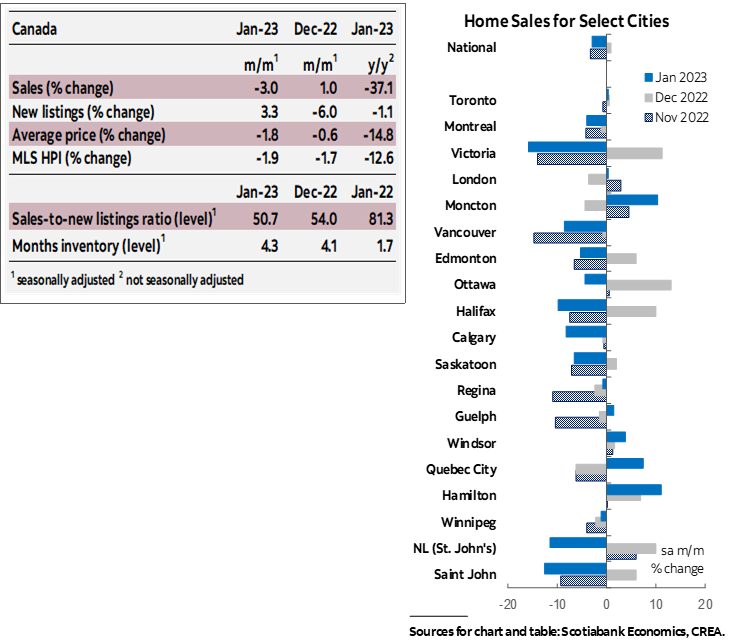
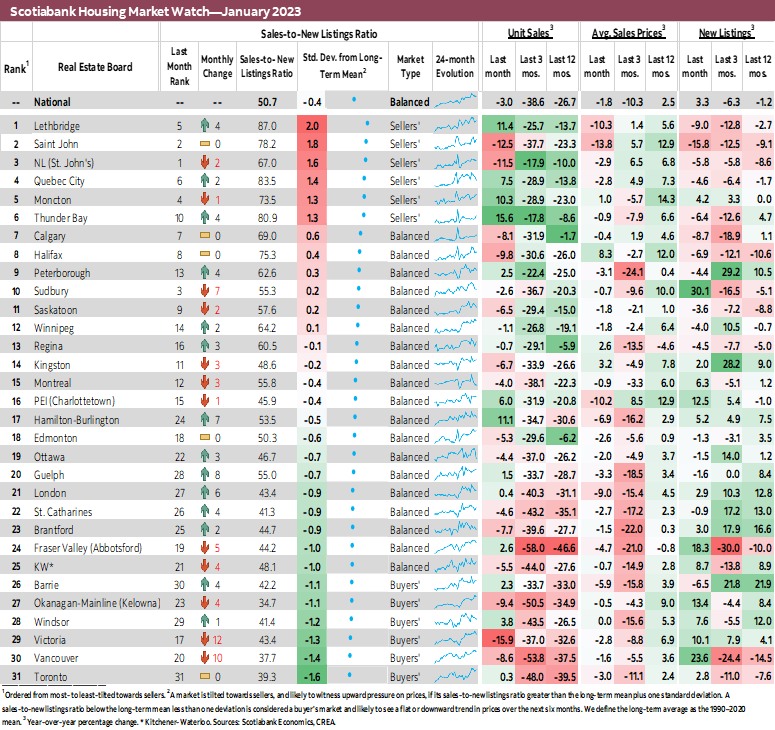
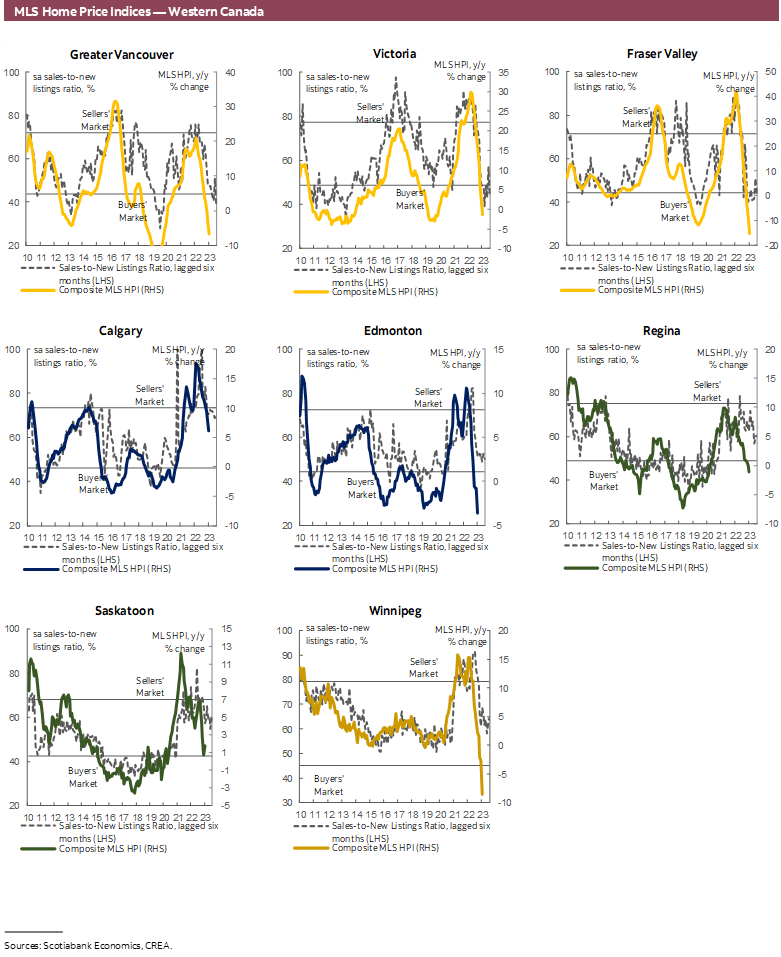
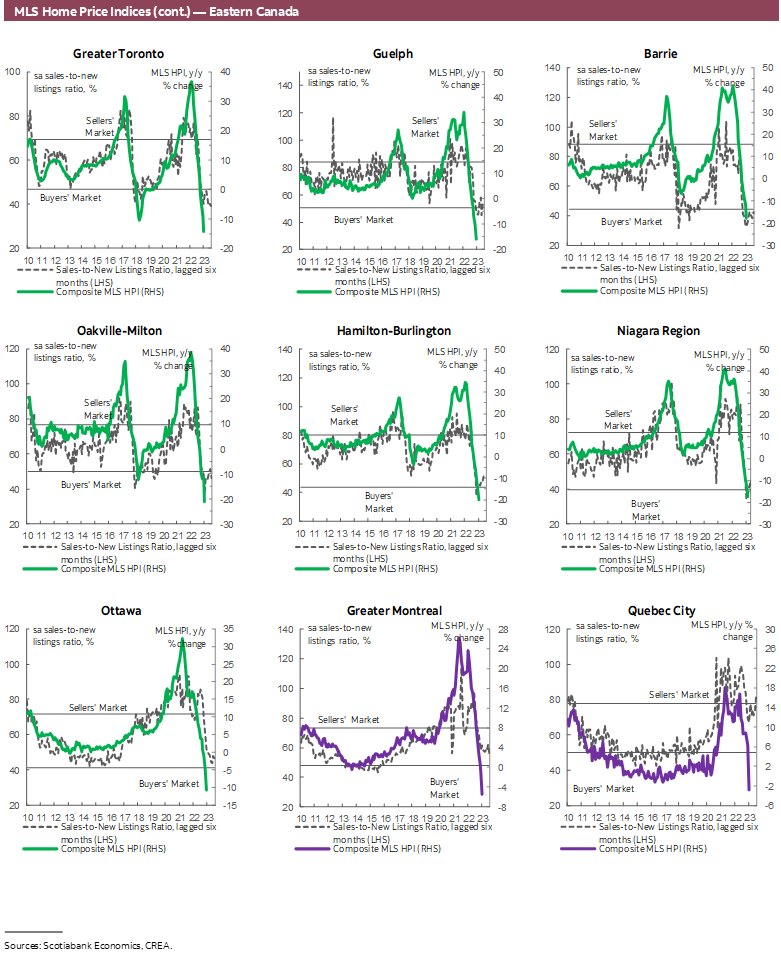
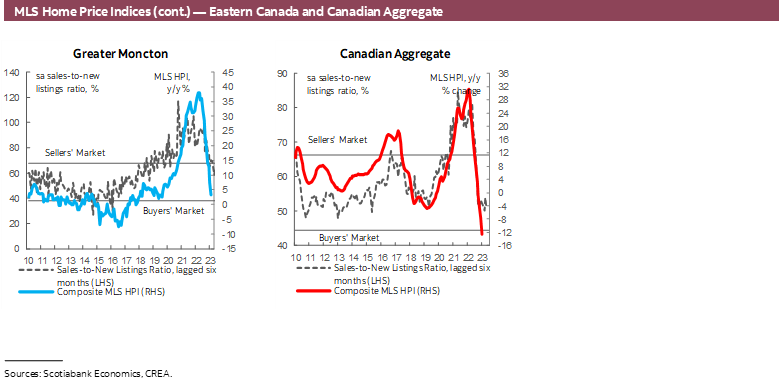
DISCLAIMER
This report has been prepared by Scotiabank Economics as a resource for the clients of Scotiabank. Opinions, estimates and projections contained herein are our own as of the date hereof and are subject to change without notice. The information and opinions contained herein have been compiled or arrived at from sources believed reliable but no representation or warranty, express or implied, is made as to their accuracy or completeness. Neither Scotiabank nor any of its officers, directors, partners, employees or affiliates accepts any liability whatsoever for any direct or consequential loss arising from any use of this report or its contents.
These reports are provided to you for informational purposes only. This report is not, and is not constructed as, an offer to sell or solicitation of any offer to buy any financial instrument, nor shall this report be construed as an opinion as to whether you should enter into any swap or trading strategy involving a swap or any other transaction. The information contained in this report is not intended to be, and does not constitute, a recommendation of a swap or trading strategy involving a swap within the meaning of U.S. Commodity Futures Trading Commission Regulation 23.434 and Appendix A thereto. This material is not intended to be individually tailored to your needs or characteristics and should not be viewed as a “call to action” or suggestion that you enter into a swap or trading strategy involving a swap or any other transaction. Scotiabank may engage in transactions in a manner inconsistent with the views discussed this report and may have positions, or be in the process of acquiring or disposing of positions, referred to in this report.
Scotiabank, its affiliates and any of their respective officers, directors and employees may from time to time take positions in currencies, act as managers, co-managers or underwriters of a public offering or act as principals or agents, deal in, own or act as market makers or advisors, brokers or commercial and/or investment bankers in relation to securities or related derivatives. As a result of these actions, Scotiabank may receive remuneration. All Scotiabank products and services are subject to the terms of applicable agreements and local regulations. Officers, directors and employees of Scotiabank and its affiliates may serve as directors of corporations.
Any securities discussed in this report may not be suitable for all investors. Scotiabank recommends that investors independently evaluate any issuer and security discussed in this report, and consult with any advisors they deem necessary prior to making any investment.
This report and all information, opinions and conclusions contained in it are protected by copyright. This information may not be reproduced without the prior express written consent of Scotiabank.
™ Trademark of The Bank of Nova Scotia. Used under license, where applicable.
Scotiabank, together with “Global Banking and Markets”, is a marketing name for the global corporate and investment banking and capital markets businesses of The Bank of Nova Scotia and certain of its affiliates in the countries where they operate, including; Scotiabank Europe plc; Scotiabank (Ireland) Designated Activity Company; Scotiabank Inverlat S.A., Institución de Banca Múltiple, Grupo Financiero Scotiabank Inverlat, Scotia Inverlat Casa de Bolsa, S.A. de C.V., Grupo Financiero Scotiabank Inverlat, Scotia Inverlat Derivados S.A. de C.V. – all members of the Scotiabank group and authorized users of the Scotiabank mark. The Bank of Nova Scotia is incorporated in Canada with limited liability and is authorised and regulated by the Office of the Superintendent of Financial Institutions Canada. The Bank of Nova Scotia is authorized by the UK Prudential Regulation Authority and is subject to regulation by the UK Financial Conduct Authority and limited regulation by the UK Prudential Regulation Authority. Details about the extent of The Bank of Nova Scotia's regulation by the UK Prudential Regulation Authority are available from us on request. Scotiabank Europe plc is authorized by the UK Prudential Regulation Authority and regulated by the UK Financial Conduct Authority and the UK Prudential Regulation Authority.
Scotiabank Inverlat, S.A., Scotia Inverlat Casa de Bolsa, S.A. de C.V, Grupo Financiero Scotiabank Inverlat, and Scotia Inverlat Derivados, S.A. de C.V., are each authorized and regulated by the Mexican financial authorities.
Not all products and services are offered in all jurisdictions. Services described are available in jurisdictions where permitted by law.

